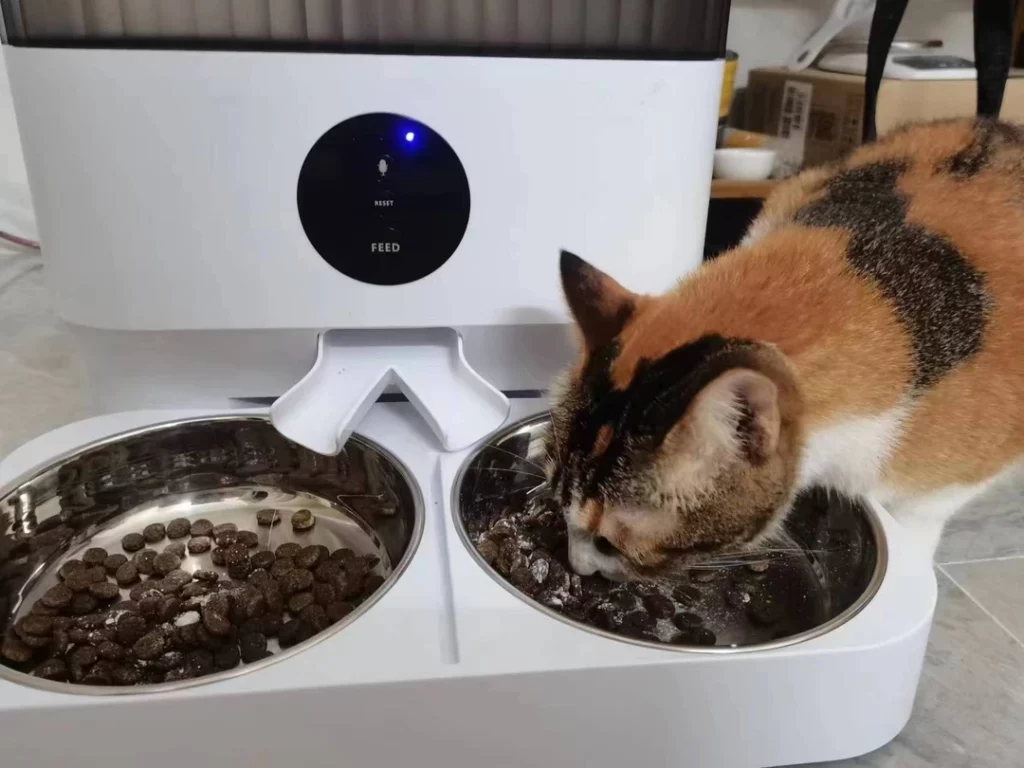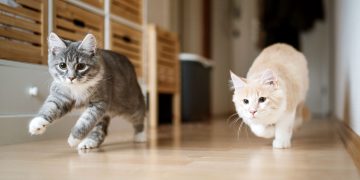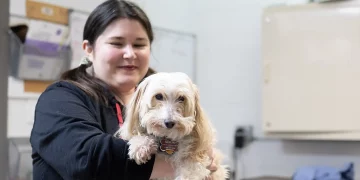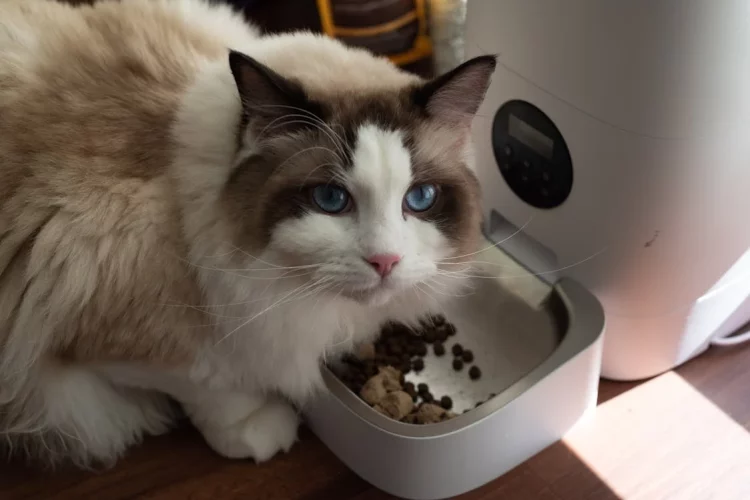Introduction:
As technology continues to play an increasingly significant role in our daily lives, it has also found its way into the pet care industry. One of the most recent innovations in pet care is the smart feeder, a device that allows pet owners to schedule and monitor their pets’ meals remotely. These devices are equipped with features such as portion control, meal timing, and most notably, data tracking. The data tracking function allows owners to monitor their pet’s feeding habits, track consumption patterns, and analyze trends that may impact their pet’s health.
With obesity and other diet-related health issues on the rise in pets, owners are looking for ways to improve their pets’ eating habits. But can a smart feeder with data tracking truly help in this regard? In this article, we will explore the features and benefits of smart feeders, how data tracking works, and whether these devices can truly improve your pet’s eating habits and overall health.
1. What is a Smart Feeder?
A smart feeder is an automatic feeding device designed to dispense food to pets at scheduled times and in specific quantities. These feeders can be controlled remotely through smartphone apps, allowing pet owners to manage their pets’ feeding schedule and portion sizes with ease. Smart feeders are equipped with advanced technology that enables various functionalities such as:
- Portion Control: Ensuring that your pet gets the right amount of food at each meal.
- Meal Scheduling: Setting specific times for meals to regulate your pet’s eating routine.
- Voice Interaction: Some smart feeders have built-in speakers that allow pet owners to communicate with their pets.
- Data Tracking: The ability to monitor your pet’s feeding times, portion sizes, and eating patterns.
The data tracking feature, in particular, is what sets smart feeders apart from traditional feeding methods. This functionality gives owners detailed insights into their pets’ eating habits and can help identify any changes or irregularities that might require attention.
2. How Does Data Tracking Work in Smart Feeders?
Data tracking in smart feeders typically involves recording various aspects of your pet’s feeding behavior. These can include:
a. Meal Frequency and Timing
The feeder tracks when your pet eats and how often. It logs the time of day and the frequency of meals, allowing you to analyze patterns and make adjustments if necessary. For example, if your pet is eating at unusual times, such as in the middle of the night, you can identify this and adjust their feeding schedule.
b. Portion Sizes
Smart feeders can track the amount of food dispensed at each feeding session. This helps to ensure that your pet is receiving the correct portion size, preventing overeating or underfeeding. The data can show whether your pet is consistently eating more or less than the recommended portion size, which can help identify potential weight management issues.
c. Eating Speed
Some advanced smart feeders even track how quickly your pet consumes their food. Rapid eating can be a sign of anxiety, stress, or simply a habit that can lead to digestive issues, such as bloating or vomiting. By monitoring this behavior, you can adjust the feeding method (e.g., using slow-feed bowls) to improve your pet’s eating habits.
d. Food Preferences
Many smart feeders allow you to track which foods your pet prefers, especially if you use a variety of food types. This feature can help ensure your pet is eating a balanced diet and that their preferences are taken into consideration when planning future meals.
e. Health Insights
The data collected by the feeder can also be integrated with other pet health data, such as weight tracking and activity levels, to provide a holistic view of your pet’s health. This comprehensive data can help you and your veterinarian make informed decisions regarding your pet’s diet, exercise, and overall health management.
3. How Can Data Tracking Help Improve Your Pet’s Eating Habits?
With all the data collected from smart feeders, the question arises: can this information actually improve your pet’s eating habits? The short answer is yes. Here’s how:
a. Improved Portion Control
Obesity is a common health problem in pets, and one of the leading causes is overfeeding. Many pet owners unknowingly feed their pets too much food, either by not measuring portions properly or by offering too many treats. Smart feeders eliminate the guesswork by providing accurate portion sizes and tracking how much food your pet consumes at each meal. This can prevent overeating, helping to maintain a healthy weight for your pet.
b. Establishing Healthy Meal Timing
Irregular feeding times or inconsistent meal schedules can contribute to poor eating habits, digestive issues, and even behavioral problems in pets. By using a smart feeder, you can set a consistent meal schedule for your pet. This helps regulate their metabolism, improve digestion, and reduce the chances of begging or overeating between meals. Regular meals can also reduce stress for pets that thrive on routine.
c. Identifying and Addressing Eating Disorders
The data tracking feature can help identify if your pet is eating too quickly, too slowly, or if there are other irregular eating behaviors. For example, pets that eat too quickly may be at risk of gastrointestinal problems like bloating or vomiting. Smart feeders can help you detect these issues early, allowing you to address them through changes in feeding habits or food types, such as introducing slow-feed bowls or switching to smaller, more frequent meals.
d. Managing Food Preferences
If your pet consistently shows a preference for one type of food over another, data tracking can help you adjust their diet accordingly. You can track whether your pet is turning away from a specific type of food or if they are not finishing their meals. This insight allows you to tailor their diet to ensure they are getting all the necessary nutrients without any food wastage. It can also help identify potential food sensitivities or allergies that need to be addressed.
e. Monitor Changes in Eating Habits
Pets can’t always communicate when something is wrong, but changes in eating habits often signal underlying health problems. If your pet suddenly eats significantly more or less than usual, or if their eating times change, this can be a sign of a health issue. With data tracking, you can spot these changes early and consult with your veterinarian for further investigation. Early detection can lead to quicker treatment and prevent serious health problems down the line.

4. Are Smart Feeders a Reliable Solution for Improving Eating Habits?
While smart feeders with data tracking features offer many benefits, they are not a one-size-fits-all solution. Here are some points to consider before investing in one for your pet:
a. Accuracy and Reliability
The effectiveness of a smart feeder depends on the quality of the device and its sensors. Not all smart feeders are equally reliable when it comes to portion control, meal timing, and data tracking. It’s important to choose a high-quality feeder with positive reviews from other pet owners.
b. Behavioral Factors
While data tracking can provide useful insights, it’s important to remember that eating habits are also influenced by behavior and environmental factors. If your pet has anxiety, stress, or other emotional issues, these could affect their eating habits, regardless of the feeding schedule. In such cases, a smart feeder alone might not address the root cause of the problem, and additional behavioral training or veterinary care may be needed.
c. Integration with Other Health Tracking Devices
For data tracking to be most effective, it should be integrated with other pet health monitoring devices. For example, if your pet wears a fitness tracker or has a weight-monitoring system in place, combining this data with their eating habits could give a more complete picture of their health. This integrated approach can provide you and your veterinarian with valuable insights that can guide your pet’s care.
5. Conclusion: Can Smart Feeders Truly Improve Eating Habits?
In conclusion, smart feeders with data tracking capabilities can play a significant role in improving your pet’s eating habits and managing their health. By offering precise portion control, consistent meal timing, and the ability to track eating behavior, these devices can help reduce overeating, prevent obesity, and identify potential health issues early. However, they should not be seen as a cure-all solution. For the best results, they should be used in conjunction with a balanced diet, regular veterinary check-ups, and, in some cases, behavioral training.
If you’re looking for a convenient way to manage your pet’s meals, a smart feeder with data tracking is a great investment. However, as with any pet care tool, it’s important to monitor your pet’s overall well-being and make adjustments as needed. With the right balance of technology and attention to your pet’s needs, smart feeders can help foster healthier eating habits and contribute to a longer, happier life for your furry friend.























































